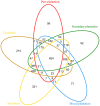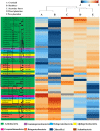Soil Bacterial Community Structure and Co-occurrence Pattern during Vegetation Restoration in Karst Rocky Desertification Area
- PMID: 29250053
- PMCID: PMC5717032
- DOI: 10.3389/fmicb.2017.02377
Soil Bacterial Community Structure and Co-occurrence Pattern during Vegetation Restoration in Karst Rocky Desertification Area
Abstract
Vegetation restoration has been widely used in karst rocky desertification (KRD) areas of southwestern China, but the response of microbial community to revegetation has not been well characterized. We investigated the diversity, structure, and co-occurrence patterns of bacterial communities in soils of five vegetation types (grassland, shrubbery, secondary forest, pure plantation and mixed plantation) in KRD area using high-throughput sequencing of the 16S rRNA gene. Bray-Curtis dissimilarity analysis revealed that 15 bacterial community samples were clustered into five groups that corresponded very well to the five vegetation types. Shannon diversity was positively correlated with pH and Ca2+ content but negatively correlated with organic carbon, total nitrogen, and soil moisture. Redundancy analysis indicated that soil pH, Ca2+ content, organic carbon, total nitrogen, and soil moisture jointly influenced bacterial community structure. Co-occurrence network analysis revealed non-random assembly patterns of bacterial composition in the soils. Bryobacter, GR-WP33-30, and Rhizomicrobium were identified as keystone genera in co-occurrence network. These results indicate that diverse soil physicochemical properties and potential interactions among taxa during vegetation restoration may jointly affect the bacterial community structure in KRD regions.
Keywords: bacterial communities; co-occurrence; karst; rocky desertification; vegetation restoration.
Figures





References
-
- Bakker M. G., Otto-Hanson L., Lange A. J., Bradeen J. M., Kinkel L. L. (2013). Plant monocultures produce more antagonistic soil Streptomyces communities than high-diversity plant communities. Soil Biol. Biochem. 65 304–312. 10.1016/j.soilbio.2013.06.007 - DOI
-
- Brand D. G., Kehoe P., Connors M. (1986). Coniferous afforestation leads to soil acidification in Central Ontario. Can. J. For. Res. 16 1389–1391. 10.1139/x86-248 - DOI
LinkOut - more resources
Full Text Sources
Other Literature Sources
Miscellaneous

